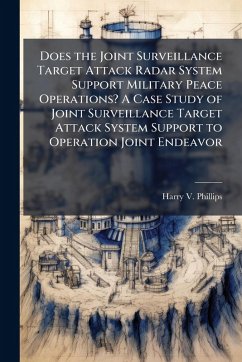
Intelligence, Surveillance, and Reconnaissance Processing, Exploitation, and Dissemination System in Support of Global Strike in 2035
Versandkostenfrei!
Versandfertig in über 4 Wochen
14,99 €
inkl. MwSt.
Weitere Ausgaben:

PAYBACK Punkte
7 °P sammeln!
"Strike" is not the main challenge facing Global Strike in 2035-it is to globally attribute, target, and assess the strike. The United States cannot afford worldwide sensors to perform this role, but it does not have to. Much of the information required is already being collected-the US just needs to grab it, process, exploit, and disseminate it. This means the US needs the ability to connect to (currently) undiscovered data sources and process that data in currently unanticipated ways to support unanticipated users. One system that is good at processing new information in new ways is the huma...
"Strike" is not the main challenge facing Global Strike in 2035-it is to globally attribute, target, and assess the strike. The United States cannot afford worldwide sensors to perform this role, but it does not have to. Much of the information required is already being collected-the US just needs to grab it, process, exploit, and disseminate it. This means the US needs the ability to connect to (currently) undiscovered data sources and process that data in currently unanticipated ways to support unanticipated users. One system that is good at processing new information in new ways is the human brain. If the US could design its Processing, Exploitation, and Dissemination (PED) architecture to function similarly to the human brain, the system could support unanticipated needs more easily. The power of this "brain" to support global strike also makes it a center of gravity for the US. Thus, the PED "Brain" must be built with integrated defenses from the start to prevent its compromise or destruction. If the interface, data, and security standards can be constructed up front, the system can evolve incrementally to fit within whatever budgets are available, and eventually can become self-constructing. The design enables this behavior by segregating all processing and data into distinct nodes which mimic the behavior of neurons in the brain, where the links between nodes may be more important than the information and processing within each node itself. This work has been selected by scholars as being culturally important, and is part of the knowledge base of civilization as we know it. This work was reproduced from the original artifact, and remains as true to the original work as possible. Therefore, you will see the original copyright references, library stamps (as most of these works have been housed in our most important libraries around the world), and other notations in the work. This work is in the public domain in the United States of America, and possibly other nations. Within the United States, you may freely copy and distribute this work, as no entity (individual or corporate) has a copyright on the body of the work. As a reproduction of a historical artifact, this work may contain missing or blurred pages, poor pictures, errant marks, etc. Scholars believe, and we concur, that this work is important enough to be preserved, reproduced, and made generally available to the public. We appreciate your support of the preservation process, and thank you for being an important part of keeping this knowledge alive and relevant.












